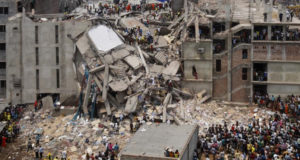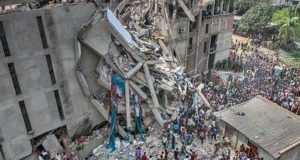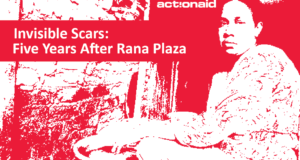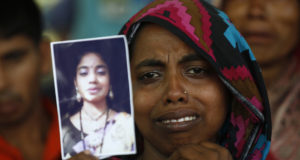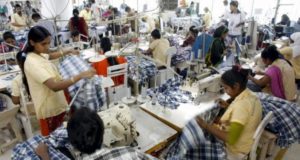April 25, 2018 marked the fifth year anniversary of the collapse of Rana Plaza. The entire nation and the world commemorated the tragic day on which the commercial building, which housed three separate garments factories, collapsed in less than 30 seconds, resulting in the untimely death of over 1,100 workers.
Read More »Two garment factory disasters a century apart show how globalization has sapped labor’s power
It would take weeks before the full number of dead from the Rana Plaza factory collapse was clear.
Read More »Workers’ empowerment key to sustaining workplace safety
Labour leaders say unions need to be independent of foreign funding and NGOs and must unite to fight for their rights
Read More »Five years after Rana Plaza many workers still work in unsafe conditions
Although safety is a higher priority five years on from the Rana Plaza disaster in Bangladesh that killed 1,135 garment workers, dangerous conditions persist in smaller factories, campaigners said.
Read More »Bangladesh’s garment industry now a model for workplace safety
On this day five years ago, Rana Plaza collapsed, and with it went 1,138 lives and irrevocably changed those of thousands others.
Read More »Almost half of Rana Plaza survivors still unemployed: study
A survey conducted by Action Aid Bangladesh has found that around half of the Rana Plaza survivors have been left unable to work.
Read More »5 years after the world’s largest garment factory collapse, is safety in Bangladesh any better?
It’s considered the worst garment industry accident of all time: An eight-story building housing several garment factories and a shopping center called Rana Plaza collapsed five years ago in Bangladesh, killing more than 1,000 workers and injuring more than 2,500.
Read More »‘Garment Worker Diaries’ reveal the plight of garment workers
A research of the garment sector in India, Bangladesh and Cambodia, commissioned in the aftermath of the Rana Plaza disaster that led to scores of workers’ deaths, has revealed the poor wage and working conditions prevailing in the sector.
Read More »Women workers push for rights in Bangladesh’s fashion factories
When Ayesha Akhter walks into the factory where she works, the supervisor greets her with a smile and wishes her a pleasant day - a major change after years of physical and verbal abuse from managers in Bangladesh’s $28 billion garment industry.
Read More »New transparency initiative to digitally map Bangladeshi factories
Sourcemap, a New York City tech start-up is building a platform, that could transform the fashion industry: a digital map of all clothing manufacturers in Bangladesh.
Read More » CPD RMG Study Stitching a better future for Bangladesh
CPD RMG Study Stitching a better future for Bangladesh
